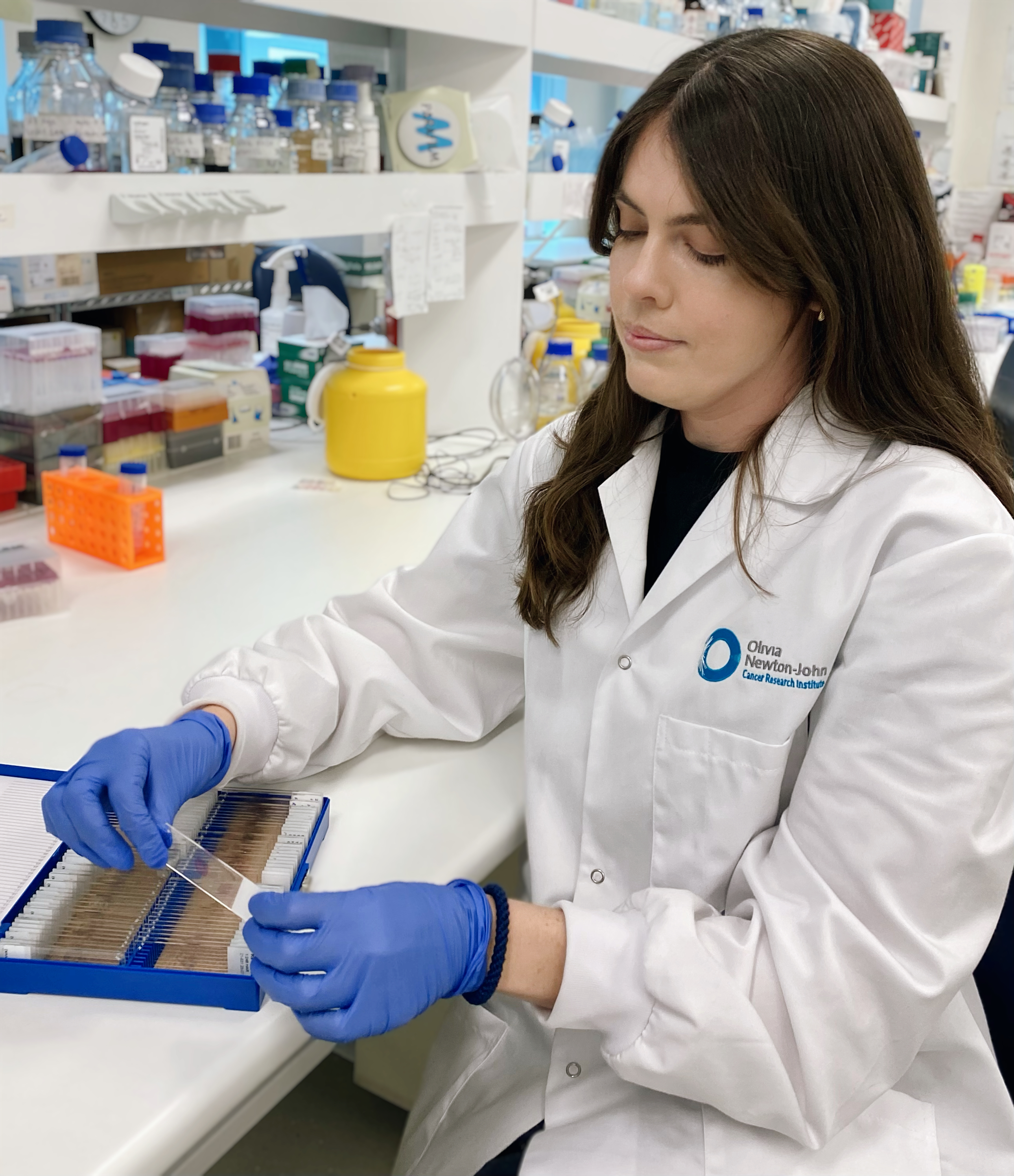
Endometrial cancer accounted for 90% of uterine cancers diagnosed in Australia in 2016. In fact, between the years 1997 and 2018, there was a 144% increase in the number of deaths due to endometrial cancer (Cancer Australia, 2022). And yet, it remains one of the most overlooked areas of research and the most commonly diagnosed cancer that occurs in the uterus.
Thankfully, researchers like Dr Tracy O’Mara work tirelessly to improve outcomes for this cancer. With her 2018 Cure Cancer grant, Dr Tracy was able to perform a cross-cancer study of ovarian and endometrial cancer, combining genetic data from more than 30,000 endometrial and ovarian cancer patients. This led to the discovery of 11 genetic sequences that affect a woman’s risk of developing endometrial and ovarian cancer, including four that were previously unknown to researchers. Recently, Dr Tracy has also participated in a larger cross-cancer study which includes genetic data from >900,000 people to investigate 12 different cancer types.
In her endometrial cancer research, Dr Tracy performed a genetic analysis to identify genes involved in cancer development. Her team was able to highlight eight genes that appear to increase a woman's risk of developing endometrial cancer. They were also able to pinpoint the actual tissues that some of these genes are acting in. With this information, her team has gathered important insight into the underlying biology of endometrial cancer and its development. They are now able to look into drugs that could be used to treat endometrial cancer.
We caught up with Dr Tracy O’Mara to learn more about her analyses on these genetic data and the exciting advancements in this area of cancer research.
Has there been any exciting trends about endometrial cancer research lately?
A new genetic analysis that has gained traction in recent years is Mendelian randomisation. This analysis uses genetic information to assess whether there is evidence for a causal relationship between a particular exposure and disease risk – it’s been described as a “genetic based randomised control trial”. This analysis has been successful in identifying new factors or confirming known risk factors for gynaecological diseases, such as the relationship between obesity and endometrial cancer risk. My group, and other researchers, have shown that obesity appears to be causal for developing endometrial cancer. However, the mechanisms underlying this relationship are not known. I recently contributed to a research project led by a team at the University of Bristol who used Mendelian randomisation techniques to tease this relationship apart, finding certain hormones that are important in increasing endometrial cancer risk. This is just one example of how this powerful technique is being used and further analyses will no doubt shed more light on other risk factors for gynaecological cancers.
Another exciting movement in endometrial cancer treatment is the increased support for immunotherapy in treatment of certain subtypes of this cancer. Treatment options for endometrial cancer patients are limited, particularly for advanced or recurrent endometrial cancer and the last drugs approved for this cancer were over 50 years ago. However, in the last year, this number has more than doubled with three immunotherapeutic drugs approved for use for certain subtypes of endometrial cancer in Australia by the TGA. However, despite this breakthrough, there remains a significant number of endometrial cancer patients that will not respond to current treatments and it is important to discover new therapeutic options. We have been using genetic information to identify proteins that could be targeted for treatment and also examined expression patterns amongst patients in an effort to highlight therapies which could be repurposed for endometrial cancer risk. We have been excited by our results so far and looking forward to pursuing our findings further.
Can you tell us more about your recent papers or studies?
Multi-tissue transcriptome-wide association study identifies eight candidate genes and tissue-specific gene expression underlying endometrial cancer susceptibility. (Kho et al., 2021)
I led this paper where we used genetic data from >100,000 women to identify genes involved in endometrial cancer development and then used gene expression information to highlight potential therapeutics which could be used for endometrial cancer. We are following up this study now with collaborators.
Genetic analyses of gynecological disease identify genetic relationships between uterine fibroids and endometrial cancer, and a novel endometrial cancer genetic risk region at the WNT4 1p36.12 locus. (Kho et al., 2021)
I led this work using Mendelian randomisation analysis (as described in the previous question) to assess the relationship between different gynaecological diseases which affect mostly pre-menopausal women and their association with endometrial cancer risk. We found evidence for a relationship between uterine fibroids and increased risk of endometrial cancer. Further work is required to understand this relationship.
Identifying molecular mediators of the relationship between body mass index and endometrial cancer risk: a Mendelian randomization analysis. (Hazelwood E., et al., 2022)
I contributed to this study led by collaborators at the University of Bristol which used Mendelian randomisation analysis to understand the relationship between obesity and endometrial cancer risk. We found that levels of hormones which are changed in response to increased BMI could explain part of the association with endometrial cancer. There is future scope to investigate targeting these hormones for endometrial cancer prevention.
Development and evaluation of polygenic risk scores for prediction of endometrial cancer risk in European women. (Bafiligil C., et al, 2022)
This is a very recent paper I contributed to and was led by collaborators at the University of Manchester. We assessed whether we could construct “endometrial cancer risk scores” using genetic information – in an attempt to identify who would be at an increased risk of developing this cancer in the general population. The initial results are promising and we are now further developing these scores in larger datasets and population cohorts.
References
-
Cancer Australia. 2022. Endometrial Cancer in Australia statistics. [online] Available at: <https://www.canceraustralia.gov.au/cancer-types/endometrial-cancer/statistics> [Accessed 29 June 2022].
-
Kho, P., Wang, X., Cuéllar-Partida, G., Dörk, T., Goode, E., Lambrechts, D., Scott, R., Spurdle, A., O’Mara, T. and Glubb, D., 2021. Multi-tissue transcriptome-wide association study identifies eight candidate genes and tissue-specific gene expression underlying endometrial cancer susceptibility. Communications Biology, 4(1).
-
Kho PF, Mortlock S, Endometrial Cancer Association Consortium, International Endometriosis Genetics Consortium, Rogers PAW, Nyholt DR, Montgomery GW, Spurdle AB, Glubb DM, O'Mara TA. Genetic analyses of gynecological disease identify genetic relationships between uterine fibroids and endometrial cancer, and a novel endometrial cancer genetic risk region at the WNT4 1p36.12 locus. Human Genetics 2021 140(9):1353-1365
-
Hazelwood E, Sanderson E, Tan VY, Ruth KS, Frayling TM, Dimou N, Gunter MJ, Dossus L, Newton C, Ryan N, Pournaras DJ, O'Mara TA, Davey Smith G, Martin RM, Yarmolinsky J. Identifying molecular mediators of the relationship between body mass index and endometrial cancer risk: a Mendelian randomization analysis. BMC Medicine 2022 20(1):125
-
Bafligil C, Thompson DJ, Lophatananon A, Ryan NAJ, Smith MJ, Dennis J, Mekli K, O’Mara TA, Evans DG, Crosbie EJ. Development and evaluation of polygenic risk scores for prediction of endometrial cancer risk in European women. Genetics in Medicine 2022










